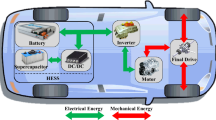Abstract
Hybrid electric vehicles (HEV) utilize electric power and a mechanical engine for propulsion; therefore, the performance of HEVs is directly influenced by the characteristics of the energy storage system (ESS). The ESS for an HEV generally requires high power performance, long cycle life, reliability and cost effectiveness; thus, a hybrid energy storage system (HESS) that combines different types of storage devices has been considered to fulfill both performance and cost requirements. To improve the operating efficiency and cycle life of a HESS, an advanced dynamic control regime in which pertinent storage devices in the HESS can be selectively operated based on their status is presented. Verification tests were performed to confirm the degree of improvement in energy efficiency. In this paper, an advanced HESS with a battery management system (BMS) that includes an optimal switching control function based on the estimated state of charge (SOC) is presented and verified.
Similar content being viewed by others
References
Barnes, J. (2003). FreedomCAR 42V Battery Test Manual. INEEL and DOE/ID-11070. April.
Cheng, D. L. and Wismer, M. G. (2007). Active control of power sharing in a battery/ultracapacitor hybrid source. 2nd IEEE ICIEA 23–25, 2913–2918.
Henson, W. (2008). Optimal battery/ultracapacitor storage combination. J. Power Sources, 179, 417–423.
Karden, E., Ploumen, S., Fricke, B. Miller, T. and Snyder, K. (2007). Energy storage devices for future hybrid electric vehicles. J. Power Sources, 168, 2–11.
Lajnef, W., Vinassa, J. M., Briat, O., Azzopardi, S. and Woirgard, E. (2007). Characterization methods and modelling of ultracapacitors for use as peak power sources. J. Power Sources, 168, 553–560.
Lam, L. T. and Loueya, R. (2006). Development of ultrabattery for hybrid-electric vehicle applications. J. Power Sources, 158, 1140–1148.
Lukic, S. M., Wirasingha, S. G., Rodriguez, F., Jian, C. and Emadi, A. (2006). Power management of an ultracapacitor/battery hybrid energy storage system in an HEV. IEEE VPPC 6–8, 1–6.
Shuai, L., Gorzine, K. A. and Ferdowsi, M. (2007). A new battery/ultracapacitor energy storage system design and its motor drive integration for hybrid electric vehicles. IEEE Trans. Vehicular Technology 56,4, Part 1, 1516–1523.
Stienecker, A. W., Flute, M. A. and Stuart, T. A. (2006a). Improved battery charging in an ultracapacitor-lead acid battery hybrid energy storage system for mild hybrid electric vehicles. SAE Paper No. 2006-01-1123.
Stienecker, A. W., Stuart, T. and Ashtiani, C. (2005). A combined ultracapacitor-lead acid battery storage system for mild hybrid electric vehicles. IEEE VPPC 7-9, 6.
Stienecker, A. W., Stuart, T. and Ashtiani, C. (2006b). An ultracapacitor circuit for reducing sulfation in lead acid batteries for mild hybrid electric vehicles. J. Power Sources, 156, 755–762.
Trinidad, F., Gimeno, C., Gutierrez, J., Ruiz, R., Sainz, J. and Valenciano, J. (2003). The VRLA modular wound design for 42 V mild hybrid systems. J. Power Sources, 116, 128–140.
Author information
Authors and Affiliations
Corresponding author
Rights and permissions
About this article
Cite this article
Shin, D.H., Lee, B.H., Jeong, J.B. et al. Advanced hybrid energy storage system for mild hybrid electric vehicles. Int.J Automot. Technol. 12, 125–130 (2011). https://doi.org/10.1007/s12239-011-0016-x
Received:
Revised:
Published:
Issue Date:
DOI: https://doi.org/10.1007/s12239-011-0016-x




